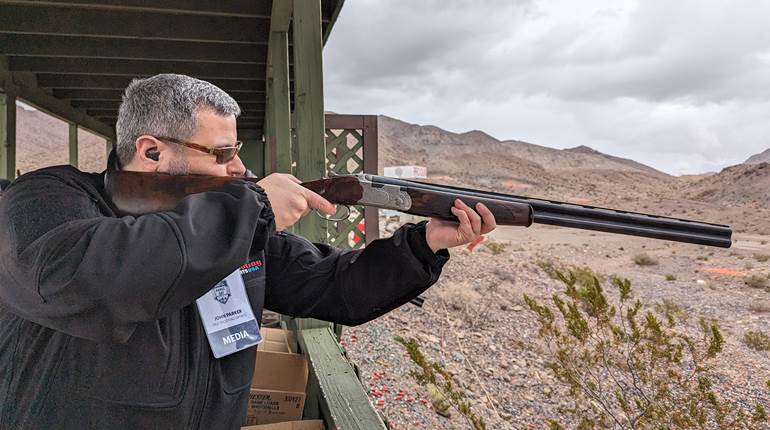
Stoeger has a well-deserved reputation for offering affordably priced, high-quality imported firearms to U.S. shooters. Its line of Condor over-under shotguns made in Brazil by E.R. Amantino is no exception. One of the more unique variants offered is the Condor Outback. The Outback is available in either 12 or 20 gauge in two configurations—blued steel with an American walnut stock set, or nickel-plated steel with a black-finished hardwood stock set. The former in 12 gauge is evaluated here.
Based on the tried-and-true Condor series, the Outback’s most noticeable characteristic is the short 20-inch length of its barrels. Whereas short barrels are quite common on slide-action shotguns and even a good number of side-by-sides, short-barreled over-under shotguns are few and far between.
Even more unique than the length of the Outback’s barrels is its sighting system. Rather than employing a more common bead sight, the Outback features a set of rifle-style sights. These include a fixed-blade front sight and a U-notch rear sight. A grooved sighting plane is located just behind the rear sight.
As with all Condor-series shotguns, the Outback is a simple, robust, no-frills over-under shotgun. The Outback is built on the Condor’s hammerless boxlock action machined from a steel casting. Rather than an expensive automatic-ejector system, the Outback features simple extractors that push both fired and unfired shells out approximately a quarter-inch as the action is opened.
The controls of the Outback are simple and straightforward and should be familiar to anyone who has used an over-under. To open the action, the blued steel top lever is moved to the right. An ambidextrous automatic safety button on the tang is engaged when the action is opened. It is important to note that the Outback does not have a barrel selector, and the bottom barrel always fires first.
As is common on over-under shotguns, the Outback sports a single trigger. Rather than a mechanical trigger, the Outback features an inertia system that requires recoil from the bottom barrel firing to reset the trigger to fire the top.
The fit and finish of the Condor Outback are quite good considering its price. The bluing on the barrels is evenly applied and deep. A matching blue finish is also on the receiver, which sports plain sides and no etched scenes. The mono-bloc is jeweled on its sides.
The buttstock and fore-end are American walnut with a satin finish. The stock set on the sample received for testing exhibited attractive grain and an evenly applied finish. The checkering on the fore-end and buttstock is laser-engraved and features a border. Although there were no overruns, many of the points of the checkering were flattened. The wood-to-metal fit of the Outback was reasonably good, and a generous one-inch-thick recoil pad capped the buttstock.
To further enhance the flexibility of the Outback, both barrels employ interchangeable choke tubes. Improved-cylinder and modified chokes are installed at the factory, although a full range of both extended and flush-fitting chokes are available.
Although the Outback would be equally suited as either a defensive shotgun or a general varmint gun, its configuration makes it ideally suited as a general-purpose camping shotgun, as it is small and compact and can be taken down into its primary components—barrels and fore-end, receiver and stock—quickly and easily. We noted during disassembly that the fore-end employed a rolling cam latch release that was somewhat difficult to engage while simultaneously pulling down on the wood to release it.
Although the selection of loadings suited to this general-purpose shotgun is extremely broad, we chose to pattern both barrels with 3-inch Federal Mag-Shok No. 4 shot turkey loads. In the course of patterning both barrels, we discovered that the light 7-pound weight of the shotgun, which would make it such a pleasure to carry afield, also made it a tad unpleasant to fire with the 3-inch loads.
Patterning both barrels revealed a slightly low and to the right point of hold for the bottom improved cylinder barrel and a slightly high and left point of hold for the upper modified barrel relative to its rifle-style sights. Both barrels provided reasonably dense and evenly spaced patterns, although the barrel with the modified choke showed a general tendency toward a thickening pattern in the center.
In terms of function, the Outback performed flawlessly. All controls operated smoothly and reliably, and the extractors worked perfectly with both fired and unfired shells. The light weight and handy size of the Outback made it surprisingly adept at breaking clays—although a conscious effort had to be made to ignore the sights. There were no malfunctions during the testing.
Considering its simple operation, handy size, good quality and extremely reasonable price, the Stoeger Condor Outback offers stack-barrel enthusiasts an unconventional but highly capable over-under shotgun.
Manufacturer : ER Amantino, Rua Fiorindo Dalla Coleta; Eramantino.com.br
Importer: Stoeger Industries; (800) 264-4962; Stoegerindustries.com
Gauge: 12, 3" (tested), 20, 3"
Action Type: Break-action, over-under shotgun
Receiver: Blued, boxlock
Barrel: 20"
Chokes: Interchangeable, improved cylinder and modified included
Trigger Pull: Bottom barrel, 5 lbs., 4 ozs.; top barrel, 4 lbs., 8 ozs.
Stock: American walnut: length of pull, 14½"; drop at heel, 2½"; drop at comb, 1½"
Overall Length: 36"
Weight: 7 lbs.
Accessories: Two choke tubes, choke tube key
Suggested Retail Price: $369






































